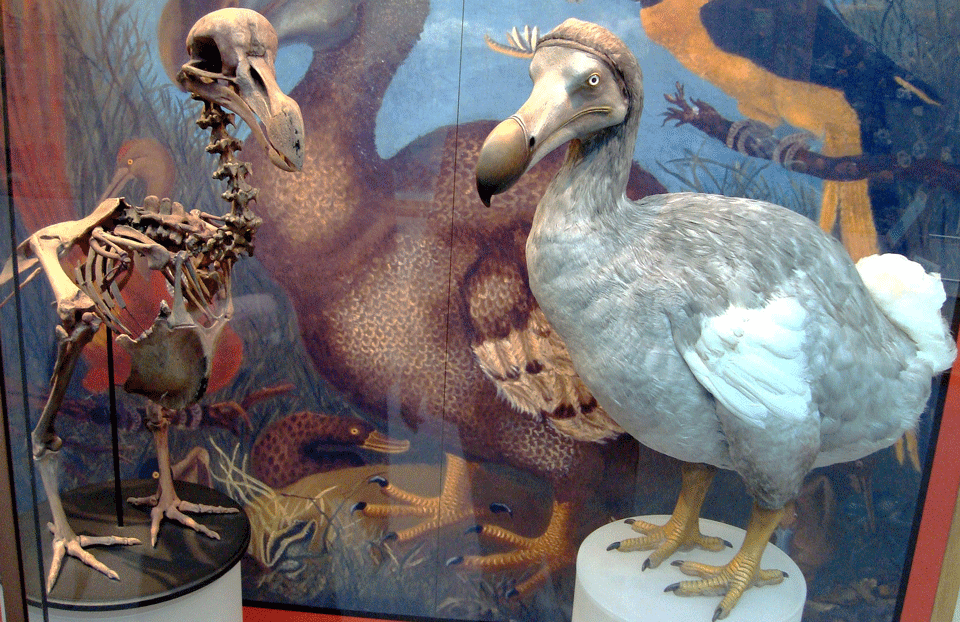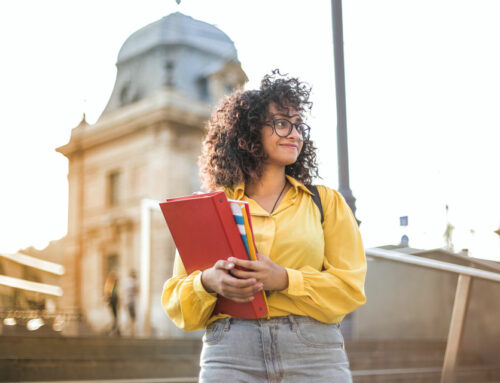The things desyred from those parts be theese in primis
On Ellophants head with the teeth In it very larg
On River horses head of the Bigest kind that can be gotton
On Seacowes head the Bigest that Canbe gotten
On Seabulles head withe hornes…
Of the habits weapons & Instruments…
Of All sorts of Serpents and Snakes Skines & Espetially of that sort that hathe a Combe on his head Lyke a Cock…
Of all sorts of Shinging Stones or of Any Strange Shape
Any thing that is strang
(1625 John Tradescant senior’s “shopping list” to Edward Nicholas, Secretary to the Admiralty)

Domenico Remp’s 1690 painting of a Cabinet of Curiosities
Are you a collector? Do you have a Cabinet of Curiosities? Would you want to build one?
Cabinets of Curiosities (or Wunderkammer – Cabinet of Wonders) began as personal collections of anything and everything (primarily of natural science and art), designed to create a sense of wonder and curiosity and “educate” the viewer. Pre-dating the establishment of universal standards of scientific classification and the curating of artefacts within public museums, these private collections reflected the interests and idiosyncrasies of wealthy individuals. At the height of their popularity, in the 17th century, collectors would create these cabinets (often whole rooms) to demonstrate their understanding of a rapidly changing world, and to show off their wealth – the more exotic and aesthetic the objects the better.
Explorers were commissioned to bring back things of amazement from the New World (above is part of a “shopping” list from John Tradescant who created the founding collection of what would later be the Ashmolean Museum in Oxford). To the modern eye, these cabinets can seem haphazard or even grotesque. Tradescant’s collection, termed Tradescant’s Ark and on display to the public for a modest entrance fee from the 1630s, included Oriental footwear, a dodo (pictured above), a mermaid’s hand, a piece of the True Cross and feathers from a phoenix’s tail, as well as more “ordinary” zoological and botanical specimens.
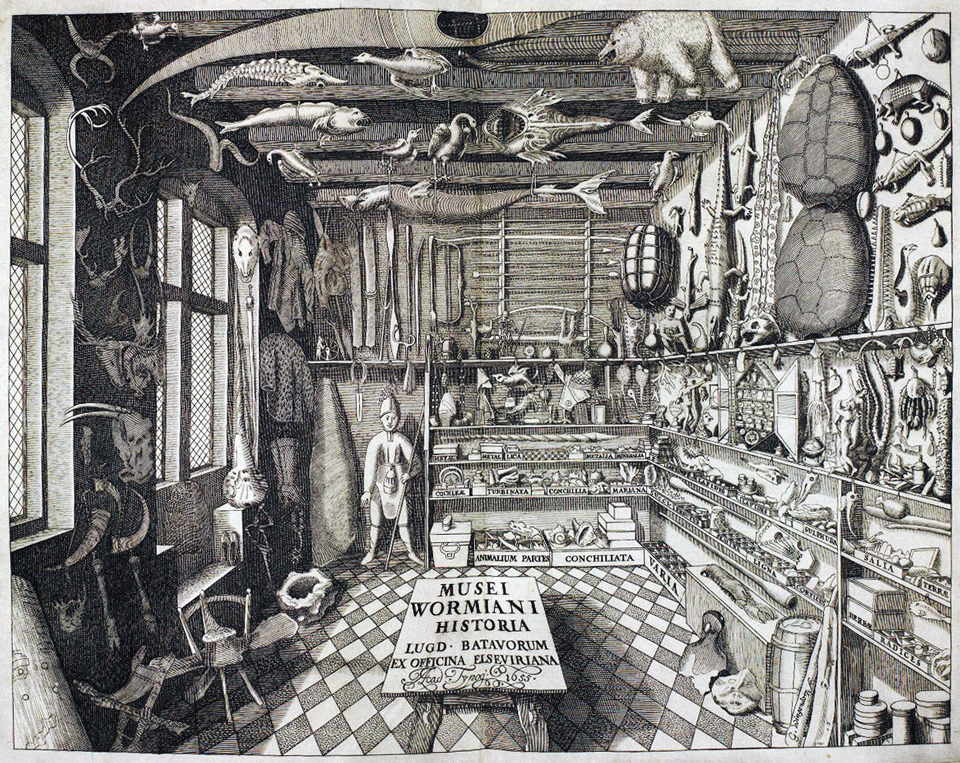
Frontispiece of Ole Worm’s book Museum Wormianum, a catalogue of his collections published in 1655. Ole Worm’s natural history collections were later combined with the Royal Cabinet of Curiosities of Frederik III, to form the original Natural History Museum of Denmark. https://www.atlasobscura.com/articles/ole-worm-cabinet
“The ideal collection should be nothing less than a theatre of the universe…keys to the whole of knowledge.” (Samuel Quiccheberg 16th century writer). To the 17th century collector there was no clear distinction or categorisation between what was collected; all were objects of curiosity, created to entertain or stimulate discussion. Gradually, however, as classification and grouping of collections in publicly accessible museums developed during the 18th century, the cabinets were broken up or turned into displays within the museums. By the 19th century the eclectic nature of the cabinet was gone, replaced by the structured specialisation of museums.
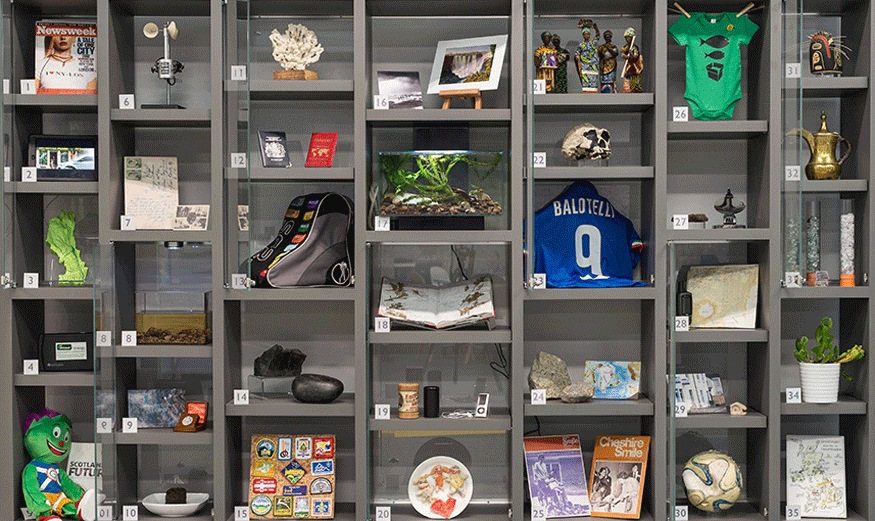
Virtual Cabinet of Curiosities, reproduced with permission from the Geography Department, Loughborough University
So, are Cabinets relevant in the 21st Century? The Cabinets were designed to evoke wonder; to connect the whole of human knowledge; to stimulate theories and ideas.
What would you think of a modern cabinet with diverse objects like a distressed football, stills of women driving cars in adverts, bleached coral, phonograph wax cylinders and iPods, and a Bedouin coffee pot? These objects form part of a modern Cabinet of Curiosities, illustrating the research and teaching interests of members of the Geography department (staff and students) at Loughborough University. The distressed football, for example, represents a study of how human traffickers, posing as football ‘agents’, exploit the hopes of West African youth who want to play professional football in Europe. The phonograph wax cylinder and iPod represent a study of how music access is changing in the urban environment of the modern world.
Labelled a ‘Virtual Cabinet of Curiosities’ by the Geography department, this term is also used about the internet itself. Originally thought of as an electronic encyclopaedia, the internet now fits the remit of a cabinet of curiosities very well; it offers a place to stimulate interest, to find new objects and ideas and where individuals can share their passions and idiosyncrasies in blogs about collections and displays. The medium may be different, but we haven’t moved that far away from the 17th century Wonder cabinets.
If you were creating a 21st century cabinet of curiosities, would it be a physical collection, or a virtual one, or perhaps a symbolic cabinet leading people to examine ideas in depth? What would you collect – natural history, art, automata, science, the weird and wonderful? Would you focus on a particular theme for your collection, reflecting your expertise in that area, or would you want to create an eclectic mix? Can you break out of the subject classification we now consider a natural part of collecting to develop new directions and depths of connection and would you want to?
Can we rediscover the wonder and amazement that we have as young children, or perhaps was felt by people in the 16th or 17th century when they first beheld an “Ellophants head with the teeth In it very larg”, or does the bombardment of images from television, cinema and YouTube leave our Wonderment forever jaded?
What would your collections say about you as a person, or the society we live in at the present time?
Let us know your thoughts about Cabinets of Curiosities at focus@potentialplusuk.org
Resources:
BBC Video Wondrous Obsessions: The Cabinet of Curiosities – Secret Knowledge
Part 1 – https://www.youtube.com/watch?v=_NDTSe4Y5JE
Part 2 – https://www.youtube.com/watch?v=FM5xSyb5EP4
11 Wonderful Wunderkammer http://mentalfloss.com/article/55324/11-wonderful-wunderkammer-or-curiosity-cabinets
Virtual Microscope’s Cabinet of Curiosities https://www.virtualmicroscope.org/content/cabinet-curiosities
Reading list for the history of collections – course description of the Opening the Cabinet of Curiosities course from the V&A Museum https://vanda-production-assets.s3.amazonaws.com/2017/11/21/11/00/29/f72c43fe-bb04-4a46-a946-aae85d24fa4a/Opening%20the%20Cabinet%20of%20Curiosities%20-%20Programme.pdf
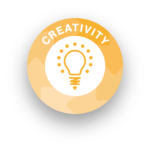
About the Author: Geraldine Glover is Potential Plus UK’s Community Information Coordinator. She is a Chartered Information Professional with a background in editorial work and information science. She is the mother of two children with high learning potential.

